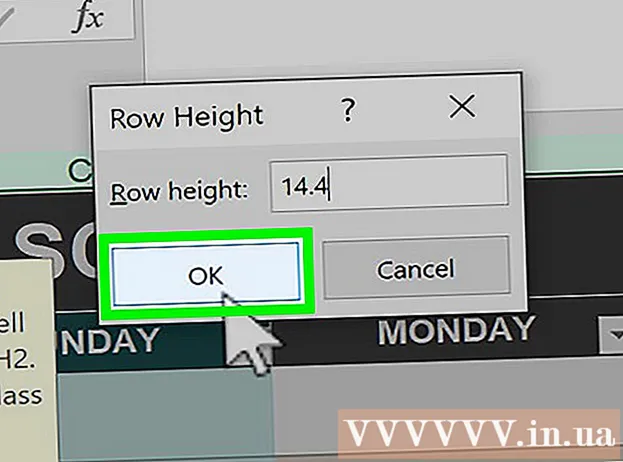Author:
Mark Sanchez
Date Of Creation:
4 January 2021
Update Date:
2 July 2024

Content
- Steps
- Part 1 of 6: How to Recognize Social Anxiety
- Part 2 of 6: How to Overcome Fear with the List Method
- Part 3 of 6: How to Develop Useful Skills
- Part 4 of 6: How to Change Your Way of Thinking
- Part 5 of 6: How to Use the Right Communication Skills
- Part 6 of 6: How to Live an Active Life
- Tips
- Warnings
Want to meet people, make new friends, and socialize, but social interactions make you fearful and uncomfortable? Social anxiety may be the cause. Many people freak out before presentations and public speaking, but social anxiety tends to interfere with daily life and is regularly accompanied by excruciating suffering. A person can constantly doubt his social adequacy and worry about the consequences of someone else's negative assessment. For people with social anxiety, psychotherapy is helpful, but there are also a number of methods that can reduce anxiety without professional intervention.
Steps
Part 1 of 6: How to Recognize Social Anxiety
 1 Learn about the symptoms of social anxiety. There are several common symptoms or sensations of social anxiety. Typical markers include:
1 Learn about the symptoms of social anxiety. There are several common symptoms or sensations of social anxiety. Typical markers include: - excessive shyness and anxiety in everyday social situations, which, as a rule, do not pose much stress for other people;
- excessive excitement about social situations several days, weeks, or months in advance;
- a pronounced fear that you are being watched or evaluated by others, especially strangers;
- avoiding social situations on a scale that limits your actions, interferes with or otherwise negatively affects your life;
- fear of humiliation;
- fear that others will notice and negatively perceive your excitement.
 2 Learn about physical symptoms. Anxiety is not only emotional. Physiological reactions occur in the body that give an idea of how you feel. Physical signs of social anxiety:
2 Learn about physical symptoms. Anxiety is not only emotional. Physiological reactions occur in the body that give an idea of how you feel. Physical signs of social anxiety: - blush on the face from a sense of shame;
- shortness of breath or uneven breathing;
- nausea or "jitters";
- trembling hands or voice;
- heart palpitations;
- increased sweating;
- dizziness and weakness.
 3 Learn to recognize your triggers (factors that provoke anxiety). Different people with social anxiety may have different triggers, although they often overlap. Knowing the reasons for the anxious reaction can help you learn to perceive such feelings in a more positive way. The provoking factors can be obvious or at first glance accidental. It is sometimes helpful to keep a diary to identify typical situations. For example:
3 Learn to recognize your triggers (factors that provoke anxiety). Different people with social anxiety may have different triggers, although they often overlap. Knowing the reasons for the anxious reaction can help you learn to perceive such feelings in a more positive way. The provoking factors can be obvious or at first glance accidental. It is sometimes helpful to keep a diary to identify typical situations. For example: - Do you get anxious when you enter class? Does the situation repeat itself in mathematics and drawing?
- Is it anxious to interact with certain people, like your boss or colleagues?
- Do you feel anxious in social situations? Do you feel the same in a restaurant and at a concert? Is socializing with close friends different from communicating with strangers?
 4 Pay attention to the situations you are trying to avoid.
4 Pay attention to the situations you are trying to avoid.- Do you always eat alone in the dining room and do not sit down with others?
- Do you always turn down invitations to parties?
- Do you rarely come to family gatherings?
- Do you try not to use public latrines?
- Other typical situations:
- New acquaintances;
- stay in the spotlight;
- performing actions under someone else's gaze;
- maintaining small talk;
- the need to respond in class;
- the need to make a phone call;
- eating or drinking in a public place;
- speaking at a meeting;
- attending parties.
Part 2 of 6: How to Overcome Fear with the List Method
 1 Face your fears. Many people with social anxiety try to shy away from their fears. This helps to reduce social anxiety in the short term, but globally the situation is only getting worse.Facing your fears is always difficult. It takes courage and determination, but if you want to get rid of your anxiety, this step is essential.
1 Face your fears. Many people with social anxiety try to shy away from their fears. This helps to reduce social anxiety in the short term, but globally the situation is only getting worse.Facing your fears is always difficult. It takes courage and determination, but if you want to get rid of your anxiety, this step is essential.  2 Make a list of situations that trigger social anxiety. Define and write down your triggers. Take a look at the list and arrange items as the anxiety intensifies. At the bottom of the list might be eye contact during a conversation, in the middle of the list is asking a stranger for directions, and at the top is the decision to ask someone out or sing karaoke.
2 Make a list of situations that trigger social anxiety. Define and write down your triggers. Take a look at the list and arrange items as the anxiety intensifies. At the bottom of the list might be eye contact during a conversation, in the middle of the list is asking a stranger for directions, and at the top is the decision to ask someone out or sing karaoke. - If you find it difficult to rank your fears, then try assigning ratings to them. For example, 1 is “frightening,” 2 is “highly frightening,” and 3 is situations that are “terrifying” for you.
 3 Take on the items on the list. Make it a goal to deal with one fear per week. For example, start with 1-rated items and work your way up to the top of the list. It's better to start with more comfortable situations and gradually build up your self-confidence before moving on to more challenging tasks.
3 Take on the items on the list. Make it a goal to deal with one fear per week. For example, start with 1-rated items and work your way up to the top of the list. It's better to start with more comfortable situations and gradually build up your self-confidence before moving on to more challenging tasks. - remember, that even a simple attempt is already a plus in the piggy bank, but for success it may take more than one attempt. Each failure will be a step towards success.
- Individuals with anxiety often use an all-or-nothing approach (for example, immediately take the courage to meet the person in a café, and if that fails, stop trying). If it didn't work out today, try it tomorrow or next week.
- Sometimes it is necessary to divide ambitious goals into subtasks. For example, if you find it difficult to hook up with a person in a cafe, then start with something smaller. For example, try smiling at a stranger in a coffee shop or sitting closer to the person you want. For some, even just going to a cafe yourself is already an achievement!
- Start small and doable tasks. Sometimes it's scary to tackle situations with a "1" rating. It is better to gradually build up your self-confidence with tiny steps than to take on a task that is too tough for you yet.
- Think of the list as a cumulative result. In case of anxiety or tension, you can take a short break. Reassess your goals and move at your own pace.
- remember, that even a simple attempt is already a plus in the piggy bank, but for success it may take more than one attempt. Each failure will be a step towards success.
Part 3 of 6: How to Develop Useful Skills
 1 Use relaxation techniques. If you find yourself uncomfortable with new social situations, learn to relax. Meditation and exercises like yoga or tai chi will help you pull yourself together and calmly prepare for challenges.
1 Use relaxation techniques. If you find yourself uncomfortable with new social situations, learn to relax. Meditation and exercises like yoga or tai chi will help you pull yourself together and calmly prepare for challenges. - If your muscles are tense, tense your entire body for three seconds (including arms, legs, neck, jaw) and then relax. Do this exercise two more times and feel relief.
- Learn to notice situations where the body is overreacting to feelings of anxiety so that you can use relaxation techniques immediately.
 2 Use breathing techniques. People with social anxiety often find themselves in situations where they panic and find it difficult to breathe. In such cases, it is best to focus on your breathing in order to calm down and take control of the situation into your own hands.
2 Use breathing techniques. People with social anxiety often find themselves in situations where they panic and find it difficult to breathe. In such cases, it is best to focus on your breathing in order to calm down and take control of the situation into your own hands. - Inhale deeply through your nose for six seconds. Feel the air pass through the chest and down into the abdomen.
- As you breathe, focus only on how you breathe in and out.
- Exhale slowly through your mouth for six seconds. Repeat the exercise until you feel calm.
 3 Choose a mantra or uplifting song. Repeat a soothing prayer, lines of poetry, a famous quote, or other text that inspires you and can help you cope with your anxiety. Find a song that gives you confidence to listen to on the way to a meeting or before an important performance.
3 Choose a mantra or uplifting song. Repeat a soothing prayer, lines of poetry, a famous quote, or other text that inspires you and can help you cope with your anxiety. Find a song that gives you confidence to listen to on the way to a meeting or before an important performance. - Even a simple "I can handle it" will help you focus and feel a surge of confidence.
 4 Change your diet. Stimulants like caffeine and nicotine often increase anxiety symptoms.Alcohol can also trigger anxiety attacks, so drink in moderation. Calming your nerves is one thing, but drinking too much is another.
4 Change your diet. Stimulants like caffeine and nicotine often increase anxiety symptoms.Alcohol can also trigger anxiety attacks, so drink in moderation. Calming your nerves is one thing, but drinking too much is another.
Part 4 of 6: How to Change Your Way of Thinking
 1 Notice negative thoughts. In moments of social anxiety, thoughts are often the culprit for negative feelings, so start noticing your thoughts to fight them. Common mistakes:
1 Notice negative thoughts. In moments of social anxiety, thoughts are often the culprit for negative feelings, so start noticing your thoughts to fight them. Common mistakes: - Mind reading - you assume that you know the thoughts of other people and that they think badly of you.
- Divination - you are trying to predict the future and assume a bad outcome. You "know" that something bad is going to happen, so you start worrying ahead of time.
- Tendency to over-dramatize - you assume the worst outcome and sure in him.
- Self-obsession - you think that others notice only bad things about you or that all the actions and words of people are connected exclusively with you.
 2 Resist negative thoughts. Once you learn to recognize negative thoughts, start analyzing and fighting them. Ask yourself questions and critically question such an idea. Use logic and facts to refute automatic negative thoughts.
2 Resist negative thoughts. Once you learn to recognize negative thoughts, start analyzing and fighting them. Ask yourself questions and critically question such an idea. Use logic and facts to refute automatic negative thoughts. - For example, if you are afraid to go to a party because everyone will notice that you are sweating and worrying, then say to yourself, “Wait a minute. Friends invited me to a party because they want to meet and spend time together. There will be dozens of people there, so where did I get the idea that everyone would be looking only at me? And how can my excitement affect our relationship? "
 3 Use positive affirmations. Try replacing negative thoughts with positive ones. When you start thinking about something bad, first try to refute the thought with facts, and then back up the idea with a positive statement.
3 Use positive affirmations. Try replacing negative thoughts with positive ones. When you start thinking about something bad, first try to refute the thought with facts, and then back up the idea with a positive statement. - For example, if you are thinking, “Nobody wants me to come,” you might say to yourself, “Wasn't I invited because they want to see me? The hostess of the party even clarified yesterday if I can come, as she hopes to see us. " Then look at yourself in the mirror and say to yourself: "I am funny and not bored with me, so everyone will be glad to me."
- You can also use other positive statements: “I try to control myself in social situations every day. Through patience and practice, I will feel more and more comfortable. "
- You can also write encouraging messages on stickers and leave them in different places, such as on the mirror or refrigerator.
 4 Don't get hung up on yourself. Interact with your surroundings so you don't get stuck in yourself. Observe people and surroundings. Try to listen to others and don't give in to bad thoughts.
4 Don't get hung up on yourself. Interact with your surroundings so you don't get stuck in yourself. Observe people and surroundings. Try to listen to others and don't give in to bad thoughts. - If you notice that you are fixated on your thoughts or on what people might think of you, then shift your attention to something else.
 5 Give less importance to other people's reactions. Anxiety is often triggered by the feeling that everyone is judging you. People may not always agree with you or respond to you, but all of this does not reflect your abilities and personal qualities. Each person has not only acquaintances with whom he gets along well, but people with whom he cannot find a common language. This is a normal part of life, not an assessment of your attractiveness to others. You learn to feel confident in any situation, so it is only important to work hard on your list. You are trying!
5 Give less importance to other people's reactions. Anxiety is often triggered by the feeling that everyone is judging you. People may not always agree with you or respond to you, but all of this does not reflect your abilities and personal qualities. Each person has not only acquaintances with whom he gets along well, but people with whom he cannot find a common language. This is a normal part of life, not an assessment of your attractiveness to others. You learn to feel confident in any situation, so it is only important to work hard on your list. You are trying!
Part 5 of 6: How to Use the Right Communication Skills
 1 Ask questions. One of the easiest ways to feel comfortable in one-on-one communication or in a group of people is to ask questions. Also, your sincere and open questions will help others relax. Start with general questions like "How was your day?" or "How are you doing with the presentation?"
1 Ask questions. One of the easiest ways to feel comfortable in one-on-one communication or in a group of people is to ask questions. Also, your sincere and open questions will help others relax. Start with general questions like "How was your day?" or "How are you doing with the presentation?" - Open-ended questions will allow the interlocutor to speak up, and not be limited to just a monosyllabic answer.The question "Would you like to see this movie?" will not lead to the same detailed answer as the question "What do you think of this film?"
 2 Listen actively and with interest. This greatly influences the situation. When a person listens, he shows his passion for the words of the interlocutor and gives them importance. Learn to listen to people and respond to comments. Don't interrupt the person so that they can express their thoughts, and also ponder their words.
2 Listen actively and with interest. This greatly influences the situation. When a person listens, he shows his passion for the words of the interlocutor and gives them importance. Learn to listen to people and respond to comments. Don't interrupt the person so that they can express their thoughts, and also ponder their words. - Pay attention to your body language. This is a very important aspect of the conversation, albeit not articulated in words. Try to look the person in the eye, not to the side or past.
- Mindfulness will also help you ask the right follow-up questions.
 3 Communicate confidently. The style of communication, called assertive, will allow you to express your feelings, thoughts, views, needs and opinions, but at the same time respect the rights of others. In assertive behavior, the person respects himself and others.
3 Communicate confidently. The style of communication, called assertive, will allow you to express your feelings, thoughts, views, needs and opinions, but at the same time respect the rights of others. In assertive behavior, the person respects himself and others. - Learn to say no. Some people do not know how to refuse, but you cannot agree to what you do not want or cannot do, otherwise dissatisfaction and stress cannot be avoided. Take care of yourself and learn to refuse people when necessary.
- Speak directly, use a neutral tone of voice and body language. Always be clear about your needs and understand that being confident and decisive doesn't always mean getting what you want.
- In a group of people at a meeting or party, try to speak a little louder than usual. Maintain eye contact and speak firmly to express your confidence.
Part 6 of 6: How to Live an Active Life
 1 Prepare for social situations. Learn to relax in advance and read the newspapers so that you have something to talk to people about. Prepare a commentary to voice or a topic for discussion at lunch. If you have to give a speech or give a presentation in front of a group of people, preparation will give you confidence.
1 Prepare for social situations. Learn to relax in advance and read the newspapers so that you have something to talk to people about. Prepare a commentary to voice or a topic for discussion at lunch. If you have to give a speech or give a presentation in front of a group of people, preparation will give you confidence. - Try to learn the speech by heart so as not to forget important points at a crucial moment.
 2 Seek support from friends and family. As you begin to deal with growing fears and concerns, reach out to loved ones for support.
2 Seek support from friends and family. As you begin to deal with growing fears and concerns, reach out to loved ones for support. - If you are going to a large event, such as a party or conference, you can bring a close friend or relative with you for support. The very presence of loved ones greatly enhances self-confidence. If you're worried, turn to your friend and banish the worried thoughts from you.
 3 Expand your social circle. People with social anxiety often find it difficult to meet new people. However, it is an important aspect of dealing with anxiety and striving to live a fulfilling life.
3 Expand your social circle. People with social anxiety often find it difficult to meet new people. However, it is an important aspect of dealing with anxiety and striving to live a fulfilling life. - Think about an activity you enjoy (like knitting, horse riding, or running) and find out which locals share your hobby. It will be much easier for you to strike up a conversation with your like-minded people.
- Always accept invitations to holidays and parties. People with social anxiety often bypass companies, but this only reinforces the feeling of isolation. Try to attend all the meetings you are invited to (even if only for half an hour). It's important to step out of your comfort zone if you want to work on yourself.
 4 Take classes to develop social skills and confidence. These activities are a great way to combine theory with practice. Meet other listeners and develop skills together.
4 Take classes to develop social skills and confidence. These activities are a great way to combine theory with practice. Meet other listeners and develop skills together.  5 Make an appointment with a psychotherapist. If after a while your efforts have not led to success, it is difficult for you to achieve the goals from the list, and your anxiety has not gone away or has intensified, you should contact a specialist.
5 Make an appointment with a psychotherapist. If after a while your efforts have not led to success, it is difficult for you to achieve the goals from the list, and your anxiety has not gone away or has intensified, you should contact a specialist.
Tips
- Understand that not all people are as confident as they seem from the outside. Many pretend, but in fact, are also afraid of social interactions.
- Be yourself. It's up to you to decide with whom and when to interact. Remember comfort and set goals for yourself.
- One of the best ways to combat social anxiety is with resonant breathing. Take a deep breath for 6 seconds, hold your breath for 6 seconds, then exhale for another 6 seconds until you feel relaxed.
- Always maintain a positive attitude. Don't give in to negative thoughts.
Warnings
- In case of full-blown panic attacks, you should see an experienced doctor. Make an appointment if you experience symptoms (the list is not exhaustive) such as shortness of breath, tremors, dizziness, and / or chest pain.



